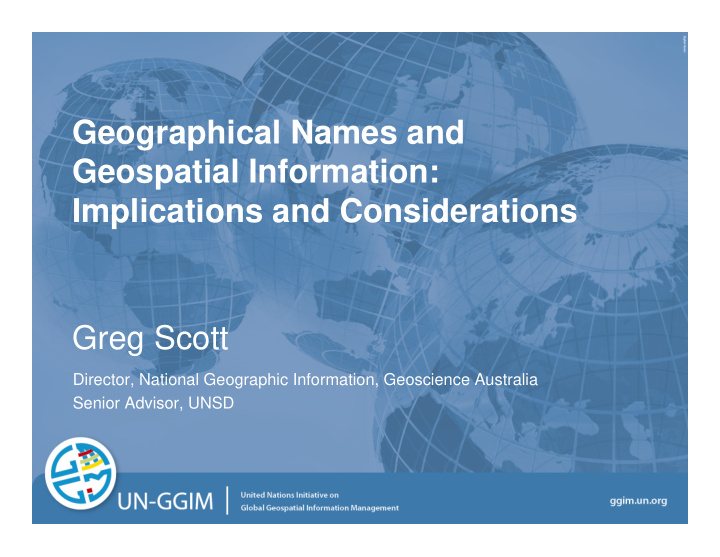



Geographical Names and Geospatial Information: Implications and Considerations Greg Scott Director, National Geographic Information, Geoscience Australia Senior Advisor, UNSD
UN-GGIM: Vision • To make accurate and authoritative geospatial information readily available to support national, regional and global development……
What’s in a name? Geographical Names Accurate, knowledgeable, consistent, sustained, reliable, standardized, transparent, enduring, agreed, official
What’s in a Geographical Names place? Address Property Building any National Administrative Spatial Data Infrastructure requires Hydrology Geospatial Information authoritative national Transport framework data themes Geographical Names Geodetic bring context and Bathymetry understanding to the data. They provide “place” to Land Use “location” Elevation Imagery
What’s the problem? • Geographical names or geospatial information – the challenges, implications and considerations are the same – ‘place’ and ‘location’ • Lack of understanding by users – geonames, geography, maps, education – interface changing • Traditional use of maps and data – points, lines, Implications and Considerations polygons, names – no longer conforms • We are used to order and structure….but the world is becoming less ordered and less structured!! • Need to move in terms of thinking, institutional arrangements, data usage, dissemination, etc. • Data is not being fully utilized. New forms of integration and dissemination required • Conversely, data is being integrated and used in ways we never imagined
Data and information…a user’s view…
Education and geography…
Thailand: One Tablet Per Child
http://www.geographycompetition.org.au/sites/default/files/2012%20Questions%20Booklet%20%282.6MB%29.pdf
Considerations for Governments • Value of authoritative and reliable geo-information is not fully realized, by community, but especially by politicians and decision makers • Too busy dealing with the issues, not the mechanisms that help provide the evidence base, information, and knowledge • Lack of institutional arrangements – no clear understanding of the roles and mandates – no policy framework and leadership • Sharing information does not come easy • Struggling to deal/compete with data from publicly and privately sourced information – credibility, accuracy, legitimacy, status • Information integration will continue to evolve at a fast pace, pushed by commercial interests and user demand • Data fusion and analytics: ‘data-information-knowledge-understanding-action-outcome’
Data fusion and analytics for evidence- based decision making…
Trajectory of Tropical Cyclone Yasi, 2-3 February 2011
Integrating geo-statistical information Queensland • Unemployment rate – 5.5% • Working age participation rate – 71.7% • Identify as Indigenous – 3.0% • Single parent families – 16.1% of families w/children • English main language spoken – 86.4%
Integrating geo-statistical information Cedar Grove Logan City • Unemployment rate – 7.2% • Working age participation rate – 70.4% Woodridge • Identify as Indigenous – 1.9% • Lone parent families – 16% of families w/children • Unemployment rate – 21.8% • English main language spoken – 92.3% • Working age participation rate – 57.9% • Identify as Indigenous – 4.8% • Lone parent families – 47% of families w/children • English main language spoken – 69.8%
Geo-statistical information integration and analysis Agreed institutional arrangements Government Better targeted Immigration decisions, interventions, Logan Community and policies Education Research & Industry Social Services Health 25 Smith St = x,y: 35.5676, 135.6587 Statistical Services Level Indicators Statistics Authority Geospatial Authority Integrating & sharing information Highest resolution Authoritative analysis & integration Geo-information Framework
Monitoring S ustainable Development: Why Location Matters?
Agenda • Professor Sir Bob Watson CMG FRS, Chief Scientific Adviser, Department for Food, Environment and Rural Affairs (Defra), UK Government • Dr Vanessa Lawrence CB, Co-chair of the United Nations Committee of Experts for GGIM and Director General and CEO, Ordnance Survey, Great Britain • Mr Greg S cott, Director, Geographic Information, Australian Government • Dr Luiz Paulo Souto Fortes, Chair of the United Nations Permanent Committee on Geographic Information for the Americas • Professor Sir John Beddington CMG FRS, Chief Scientific Advisor, United Kingdom Government
Sustainable development: location matters
Management of Geospatial information water resources in the national interest and relationships Policy development Evidence based decision making Groundwater and surface water Service modelling and delivery reporting Engaging the community Monitoring Sustainable Development: Why Location Matters United Nations Conference on Sustainable Development
The importance of geospatial information “I am also pleased to see that the importance of reliable, trusted geographic information is now recognised. The United Nations has now established a Committee of Experts of Member States, which the UK co-chairs, to move this agenda forward” Rt Hon Nick Clegg MP, Deputy Prime Minister, United Kingdom Government, Rio+20 June 2012
“The Future We Want”: 19 June 2012
Recommend
More recommend